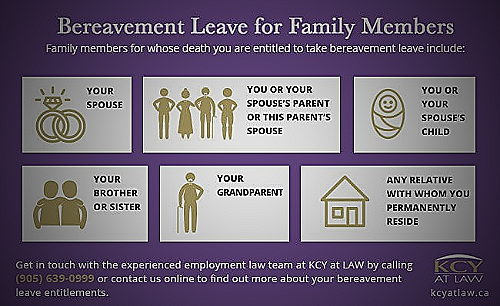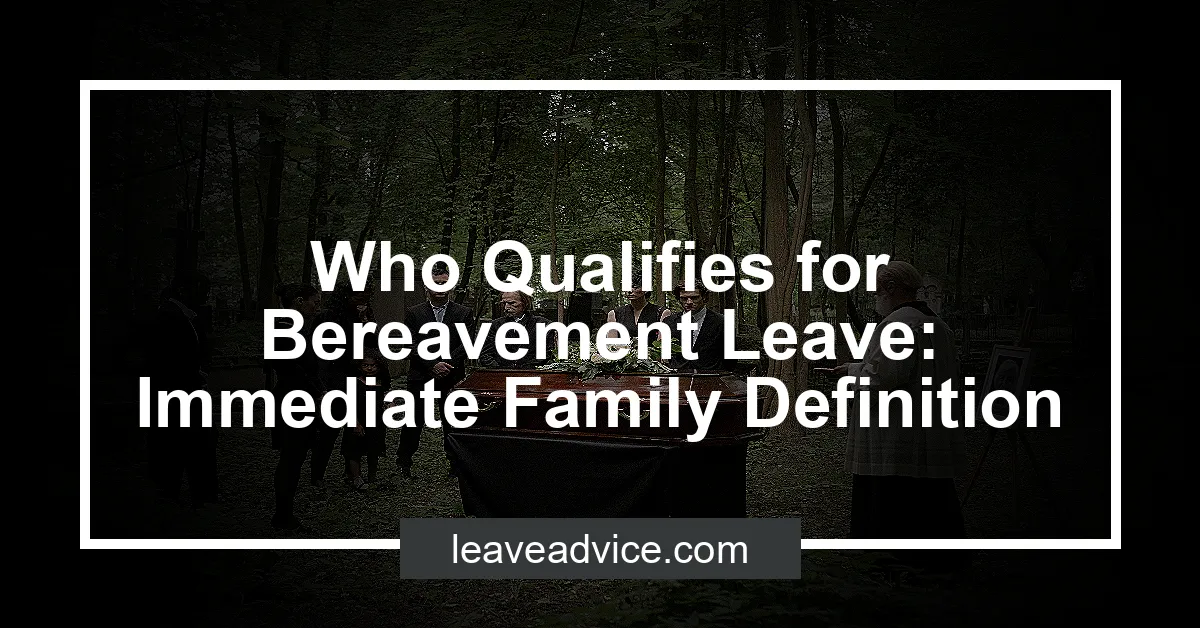Who Qualifies for Bereavement Leave: Immediate Family Definition
Bereavement leave is a crucial benefit that enables employees to deal with the emotional and practical aspects of losing a loved one without worrying about work. However, to make the most of this benefit, it is essential to understand who is considered immediate family for bereavement leave and the relevant laws and policies.
Are you curious about who is considered immediate family for bereavement leave? Check out this Youtube video titled “BEREAVEMENT LEAVE for FEDERAL EMPLOYEES” for answers and advice.
What is Bereavement Leave?
Bereavement leave is a type of leave that employers may offer to their employees in case they experience the death of an immediate family member. Its purpose is to assist the employee so that they can take time off from work to grieve and make necessary arrangements.
Who qualifies as immediate family for bereavement leave?
Immediate family members are typically defined as a spouse, child, parent, sibling, grandparent, grandchild, or the equivalent of any of these family members in the event of a domestic partnership or civil union. Depending on the employer’s discretion, immediate family members may also include step-relatives or in-laws.
How Long is Bereavement Leave?
The length of bereavement leave varies depending on the employer and the circumstances surrounding the death. Some employers may offer a set number of days of leave, while others may determine the length on a case-by-case basis.
Typically, bereavement leave may last from three to five days.
Is Bereavement Leave Paid?
Whether or not bereavement leave is paid depends on the employer’s policy. Some employers may offer paid bereavement leave, while others may offer unpaid leave or use the employee’s accumulated paid time off (PTO) or sick leave.
The employee should check with their employer about their bereavement leave policy to know if it is paid or not.
Can Bereavement Leave Be Taken for Non-Immediate Family Members?
Sometimes bereavement leave policies may have provisions for extended family members such as cousins, aunts, uncles, nieces, or nephews that are considered close kin or significant people as defined by the employee’s culture or religion. However, this varies from one employer to another, and it is recommended for employees to review their company’s bereavement leave policy for more information.
Why is Immediate Family Definition Important for Bereavement Leave?
When an employee experiences the loss of a loved one, they are often entitled to take time off from work to mourn their loss. However, not all family members are considered immediate family for the purposes of bereavement leave.
The definition of immediate family varies depending on the employment policies and state laws, so it is important for both employer and employee to understand who qualifies as immediate family.
Which individuals are classified as immediate family for bereavement leave?
The definition of immediate family for bereavement leave typically includes the employee’s spouse/domestic partner, parent, step-parent, mother-in-law, father-in-law, child, ward, custody child, foster child, brother, sister, step-brother, step-sister, brother-in-law, sister-in-law, son-in-law, daughter-in-law, grandparent, great-grandparent, grandchild, or any person residing in the employee’s household at the time of their death.
Why is it Important to Know Who Qualifies as Immediate Family?
It is important to know who qualifies as immediate family for bereavement leave because an employee’s entitlement to bereavement leave is often restricted to immediate family members only. If an employee takes bereavement leave for a non-immediate family member, they may be placing their job at risk if it is discovered that they have violated company policy or state law.
On the other hand, if the employer denies bereavement leave to an employee for an immediate family member, they may be violating the employee’s rights or violating state law. By understanding the definition of immediate family for bereavement leave, employers and employees can avoid complications and make informed decisions during difficult times.
Knowing who is considered immediate family for bereavement leave is essential for both employers and employees. It ensures that the employee can take the appropriate time off to grieve and attend to necessary tasks while also benefiting the employer by reducing the risk of legal or policy violations.
Employers should have clear policies and guidelines on bereavement leave that include the definition of immediate family, while employees should verify their eligibility with their employer prior to taking leave. By doing so, both parties can prioritize empathy and understanding during times of loss.
Who is Considered Immediate Family for Bereavement Leave?
When an employee suffers the loss of a loved one, it is understandable that they would need time off to grieve, attend funeral services, and resolve any financial or legal matters related to their loved one’s passing. This is where bereavement leave comes in, it is time off granted to an employee in the event of a family member’s death.
But then, who exactly is considered an immediate family member for bereavement leave purposes?
In general terms, “immediate family” refers to family members who are either related by blood, marriage, adoption, cohabitation, or civil partnership. However, the definition of immediate family may vary depending on the state, country, or company’s policy.
In terms of American laws, immediate family includes an employee’s spouse/domestic partner, parent, step-parent, mother-in-law, father-in-law, child, ward, custody child, foster child, brother, sister, step-brother, step-sister, brother-in-law, sister-in-law, son-in-law, daughter-in-law, grandparent, great-grandparent, grandchild, or other person who stood in loco parentis to the employee when the employee was a minor child. Some states may also define extended family members such as aunts, uncles, nieces, nephews, and cousins.
Companies may also have their own definitions of immediate family, which may be more inclusive or more restrictive than state law. For example, some companies may allow employees to take bereavement leave for the death of their best friend or their beloved pet, who may not be considered immediate family by law.
While more inclusive immediate family definitions may provide better support for employees, it may also be seen as an abuse of the system by some employees, leading to fraudulent claims. On the other hand, more restrictive definitions may be seen as insensitive and unsupportive of employees in their time of grief.
Ultimately, the decision on who is considered immediate family for bereavement leave rests with employers and the local laws they should follow.
Factors Affecting Immediate Family Definition for Bereavement Leave
Bereavement leave is a crucial period for an employee to take time off from work to grieve, plan funerals, and sort out necessary legal and financial matters following the loss of a loved one. However, who is considered “immediate family” for bereavement leave differs depending on legal and cultural factors, industry-specific standards, and the inclusion of non-biological or non-legal relatives.
Legal and Cultural Factors Affecting Definition of Immediate Family
The definition of immediate family is not a one-size-fits-all approach since it depends on the legal and cultural factors of a country or region. For instance, in some countries, the definition of immediate family is limited to children, parents, siblings, and spouses.
However, other countries may have broader definitions that include relatives like grandparents, aunts, uncles, and cousins. Similarly, certain cultures may also recognize certain family members as part of the immediate family that others may not consider.
Industry-Specific Factors Affecting Definition of Immediate Family
The definition of immediate family may also depend on industry-specific factors. For example, paramedics may have a broader definition of immediate family to include persons with whom the employee shares a “close and significant emotional bond.”
This definition can include significant others, same-sex partners, housemates, and friends.
Inclusion of Non-Biological or Non-Legal Relatives in Immediate Family Definition
Some employers may recognize non-biological or non-legal relatives as part of the employee’s immediate family. For instance, an employer may acknowledge a long-term roommate as immediate family or a parent figure who is not the employee’s biological or legal parent.
However, these decisions depend on the employer’s policy, and employees need to check their company’s bereavement leave policy for guidelines on who qualifies as immediate family.

How to Verify Relationship Status for Bereavement Leave?
When applying for bereavement leave, it’s important that the employee provide documentation and proof of their relationship status with the deceased family member. Employers need to verify that the employee is entitled to the leave.
There are legal requirements that employers need to follow when verifying immediate family status. Employers can ask for a death certificate or obituary as proof of the relationship.
If an obituary is presented, it should have the names and relationship of all immediate family members of the deceased.
If the employee can’t provide a death certificate or obituary, employers can ask for other forms of verification. This could include a birth certificate, marriage license or court order.
Employers can also ask for a note from a funeral home or religious organization as a way of verifying the relationship status.
Alternatively, some employers may allow for employees to self-identify their relationship status. This means that the employer will take the employee at their word and not require any additional documentation.
However, this is not the case for all employers. It’s important to check with the HR department or employee handbook to see what the requirements are for your specific employer.
Conclusion
Immediate family for bereavement leave includes an employee’s spouse/domestic partner, parent, step-parent, mother-in-law, father-in-law, child, ward, custody child, foster child, brother, sister, step-brother, step-sister, brother-in-law, sister-in-law, son-in-law, daughter-in-law, grandparent, great-grandparent, grandchild, or any other individual related by blood or bond through marriage, adoption, cohabitation, or civil partnership. Understanding who is considered immediate family is crucial for employees who need to take bereavement leave, as it allows them to properly grieve, attend funeral services, or deal with any necessary financial and legal matters.
Employers must also provide accurate information to state child support agencies to comply with state laws and regulations.

